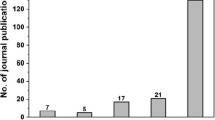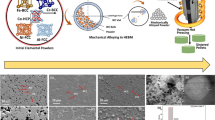Abstract
Al-Sn binary alloys are fabricated by powder consolidation using high-pressure torsion (HPT). The HPT-processed samples are immersed in pure water and hydrogen generation behavior is investigated with respect to the imposed strain through the HPT processing at a selected temperature in the range of 297–333 K. Microstructures of HPT-processed alloys are analyzed by x-ray diffraction, transmission electron microscopy (TEM), electron probe microanalysis (EPMA) and electron back scattered diffraction (EBSD) analysis. Results show that it is important to add more than 60 wt% of Sn to activate hydrogen generation from the Al-Sn alloys in pure water. TEM and EBSD images reveal significant grain refinement while EPMA results exhibit homogenous distribution of elements achieved by HPT. The grain refinement and distribution of elements attained by HPT processing influence greatly the hydrogen generation rate and yield of the alloys. An Al-80 wt% Sn alloy with an average grain size of ∼270 nm exhibits the highest hydrogen yield and generation rate in pure water at 333 K.









Similar content being viewed by others
References
Q. Li and N.J. Bjerrum: Aluminum as anode for energy storage and conversion: A review. J. Power Sources 110 (1), 1 (2002).
M. Nestoridi, D. Pletcher, R.J.K. Wood, S. Wang, R.L. Jones, K.R. Stokes, and I. Wilcock: The study of aluminium anodes for high power density Al/air batteries with brine electrolytes. J. Power Sources 178 (1), 445 (2008).
G.T. Qi, Y.B. Qiu, Y.N. Zhao, and Q.Z. Cai: The attack initiation of Al–Zn–In–Sn anode by the segregation concentrating Zn, Sn and In. Mater. Corros. 60 (3), 206 (2009).
J.B. Bessone, D.O. Flamini, and S.B. Saidman: Comprehensive model for the activation mechanism of Al–Zn alloys produced by indium. Corros. Sci. 47 (1), 95 (2005).
H.Z. Wang, D.Y.C. Leung, M.K.H. Leung, and M. Ni: A review on hydrogen production using aluminum and aluminum alloys. Renewable Sustainable Energy Rev. 13 (4), 845 (2009).
S. Elitzur, V. Rosenband, and A. Gany: Study of hydrogen production and storage based on aluminum–water reaction. Int. J. Hydrogen Energy 39 (12), 6328 (2014).
X. Huang, T. Gao, X. Pan, D. Wei, C. Lv, L. Qin, and Y. Huang: A review: Feasibility of hydrogen generation from the reaction between aluminum and water for fuel cell applications. J. Power Sources 229, 133 (2013).
X. Chen, L. Liu, Y.Y. Peter, and S.S. Mao: Increasing solar absorption for photocatalysis with black hydrogenated titanium dioxide nanocrystals. Science 331 (6018), 746 (2011).
X. Chen, S. Shen, L. Guo, and S.S. Mao: Semiconductor-based photocatalytic hydrogen generation. Chem. Rev. 110 (11), 6503 (2010).
X. Chen, C. Li, M. Grätzel, R. Kostecki, and S.S. Mao: Nanomaterials for renewable energy production and storage. Chem. Soc. Rev. 41 (23), 7909 (2012).
X. Li, J. Yu, J. Low, Y. Fang, J. Xiao, and X. Chen: Engineering heterogeneous semiconductors for solar water splitting. J. Mater. Chem. A 3 (6), 2485 (2015).
J. Yuan, J. Wen, Y. Zhong, X. Li, Y. Fang, S. Zhang, and W. Liu: Enhanced photocatalytic H2 evolution over noble-metal-free NiS cocatalyst modified CdS nanorods/gC3N4 heterojunctions. J. Mater. Chem. A 3 (35), 18244 (2015).
J. Ran, J. Zhang, J. Yu, M. Jaroniec, and S.Z. Qiao: Earth-abundant cocatalysts for semiconductor-based photocatalytic water splitting. Chem. Soc. Rev. 43 (22), 7787 (2014).
O. Khaselev and J.A. Turner: A monolithic photovoltaic-photoelectrochemical device for hydrogen production via water splitting. Science 280 (5362), 425 (1998).
S.Y. Reece, J.A. Hamel, K. Sung, T.D. Jarvi, A.J. Esswein, J.J. Pijpers, and D.G. Nocera: Wireless solar water splitting using silicon-based semiconductors and earth-abundant catalysts. Science 334 (6056), 645 (2011).
Y. Zheng, Y. Jiao, L.H. Li, T. Xing, Y. Chen, M. Jaroniec, and S.Z. Qiao: Toward design of synergistically active carbon-based catalysts for electrocatalytic hydrogen evolution. ACS Nano 8 (5), 5290 (2014).
Y. Zheng, Y. Jiao, Y. Zhu, L.H. Li, Y. Han, Y. Chen, A. Du, M. Jaroniec, and S.Z. Qiao: Hydrogen evolution by a metal-free electrocatalyst. Nat. Commun. 5, 1 (2014).
S. Chen, J. Duan, Y. Tang, B. Jin, and S.Z. Qiao: Molybdenum sulfide clusters-nitrogen-doped graphene hybrid hydrogel film as an efficient three-dimensional hydrogen evolution electrocatalyst. Nano Energy 11, 11 (2015).
J. Duan, S. Chen, M. Jaroniec, and S.Z. Qiao: Porous C3N4 nanolayers@N-graphene films as catalyst electrodes for highly efficient hydrogen evolution. ACS Nano 9 (1), 931 (2015).
Y. Zheng, Y. Jiao, M. Jaroniec, and S.Z. Qiao: Advancing the electrochemistry of the hydrogen-evolution reaction through combining experiment and theory. Angew. Chem., Int. Ed. 54 (1), 52 (2015).
M.A. Rosen: Advances in hydrogen production by thermochemical water decomposition: a review. Energy 35 (2), 1068 (2010).
H.L. Chin, Z.S. Chen, and C.P. Chou: Fedbatch operation using Clostridium acetobutylicum suspension culture as biocatalyst for enhancing hydrogen production. Biotechnol. Prog. 19 (2), 383 (2003).
H. Wang, D.Y.C. Leung, and M.K.H. Leung: Energy analysis of hydrogen and electricity production from aluminum-based processes. Appl. Energy 90 (1), 100 (2012).
M. Fan, F. Xu, and L. Sun: Studies on hydrogen generation characteristics of hydrolysis of the ball milling Al-based materials in pure water. Int. J. Hydrogen Energy 32 (14), 2809 (2007).
J.T. Ziebarth, J.M. Woodall, R.A. Kramer, and G. Choi: Liquid phase-enabled reaction of Al–Ga and Al–Ga–In–Sn alloys with water. Int. J. Hydrogen Energy 36 (9), 5271 (2011).
H. Wang, Y. Chang, S. Dong, Z. Lei, Q. Zhu, P. Luo, and Z. Xie: Investigation on hydrogen production using multicomponent aluminum alloys at mild conditions and its mechanism. Int. J. Hydrogen Energy 38 (3), 1236 (2013).
A.V. Ilyukhina, A.S. Ilyukhin, and E.I. Shkolnikov: Hydrogen generation from water by means of activated aluminum. Int. J. Hydrogen Energy 37 (21), 16382 (2012).
K. Mahmoodi and B. Alinejad: Enhancement of hydrogen generation rate in reaction of aluminum with water. Int. J. Hydrogen Energy 35 (11), 5227 (2010).
R.Z. Valiev, R.K. Islamgaliev, and I.V. Alexandrov: Bulk nanostructured materials from severe plastic deformation. Prog. Mater. Sci. 45 (2), 103 (2000).
R.Z. Valiev, Y. Estrin, Z. Horita, T.G. Langdon, M.J. Zehetbauer, and Y.T. Zhu: Producing bulk ultrafine-grained materials by severe plastic deformation. JOM 58 (4), 33 (2006).
L. Ouyang, Y. Xu, H. Dong, L. Sun, and M. Zhu: Production of hydrogen via hydrolysis of hydrides in Mg–La system. Int. J. Hydrogen Energy 34 (24), 9671 (2009).
M-S. Zou, R-J. Yang, X-Y. Guo, H-T. Huang, J-Y. He, and P. Zhang: The preparation of Mg-based hydro-reactive materials and their reactive properties in seawater. Int. J. Hydrogen Energy 36 (11), 6478 (2011).
M-Q. Fan, F. Xu, L-X. Sun, J-N. Zhao, T. Jiang, and W-X. Li: Hydrolysis of ball milling Al–Bi–hydride and Al–Bi–salt mixture for hydrogen generation. J. Alloys Compd. 460 (1–2), 125 (2008).
H. Hu, M. Qiao, Y. Pei, K. Fan, H. Li, B. Zong, and X. Zhang: Kinetics of hydrogen evolution in alkali leaching of rapidly quenched Ni–Al alloy. Appl. Catal., A 252 (1), 173 (2003).
M.Q. Fan, L.X. Sun, and F. Xu: Hydrogen production for micro-fuel-cell from activated Al–Sn–Zn–X (X: hydride or halide) mixture in water. Renewable Energy 36 (2), 519 (2011).
X. Hu, G. Zhu, Y. Zhang, Y. Wang, M. Gu, S. Yang, P. Song, X. Li, H. Fang, G. Jiang, and Z. Wang: Hydrogen generation through rolling using Al–Sn alloy. Int. J. Hydrogen Energy 37 (15), 11012 (2012).
Y. Ito and Z. Horita: Microstructural evolution in pure aluminum processed by high-pressure torsion. Mater. Sci. Eng., A 503 (1–2), 32 (2009).
K. Edalati and Z. Horita: Significance of homologous temperature in softening behavior and grain size of pure metals processed by high-pressure torsion. Mater. Sci. Eng., A 528 (25–26), 7514 (2011).
A. Alhamidi, K. Edalati, Z. Horita, S. Hirosawa, K. Matsuda, and D. Terada: Softening by severe plastic deformation and hardening by annealing of aluminum–zinc alloy: Significance of elemental and spinodal decompositions. Mater. Sci. Eng., A 610, 17 (2014).
ACKNOWLEGEMENTS
We are grateful to Prof. Hiroaki Nakano of Department of Materials Science and Engineering, Kyushu University for useful discussion. One of the authors (Fan Zhang) would like to thank the Ministry of Education, Culture, Sports, Science and Technology (MEXT) of Japan for a Ph.D scholarship. This work was supported in part by the Light Metals Educational Foundation of Japan, in part by the Grant-in-Aids from the MEXT, Japan (Nos. 22102004, 26220909, and 15K14183). The HPT process was carried out in the International Research Center on Giant Straining for Advanced Materials (IRC-GSAM) at Kyushu University.
Author information
Authors and Affiliations
Corresponding author
Rights and permissions
About this article
Cite this article
Zhang, F., Yonemoto, R., Arita, M. et al. Hydrogen generation from pure water using Al-Sn powders consolidated through high-pressure torsion. Journal of Materials Research 31, 775–782 (2016). https://doi.org/10.1557/jmr.2016.74
Received:
Accepted:
Published:
Issue Date:
DOI: https://doi.org/10.1557/jmr.2016.74




